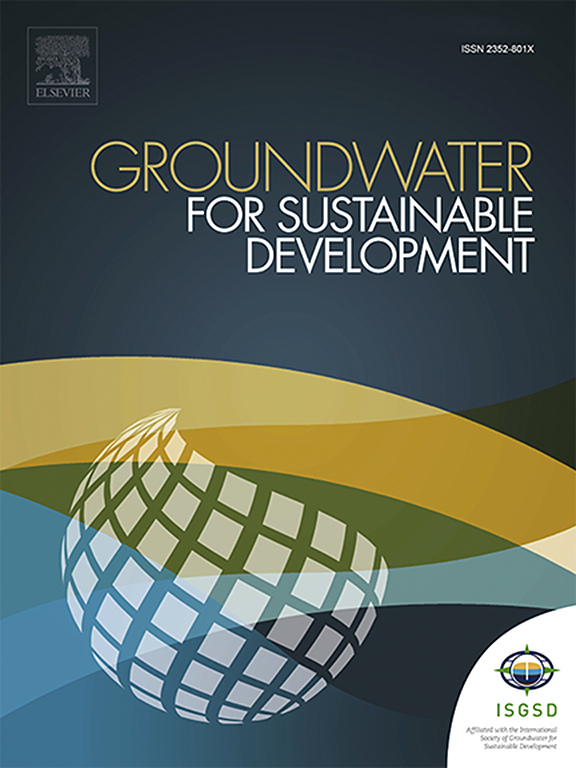扩大灌溉农业的内陆中咸淡水脱盐现状评价
IF 4.9
Q2 ENGINEERING, ENVIRONMENTAL
引用次数: 0
摘要
由于全球淡水短缺,灌溉农业面临着重大挑战,影响着可持续性和粮食安全。这增加了内陆地区地下水开采的压力,以满足对灌溉用水日益增长的需求。这一点,再加上地下水盐碱化风险的增加,使得中咸淡水(即总溶解固体从3000毫克/升到10000毫克/升)的脱盐成为农业的一个关键水源。然而,目前内陆海水淡化系统的高成本可能会影响作物的盈利能力及其农业用途的可持续性。这篇综述提出了利用中等咸水半咸水开发具有成本效益的内陆海水淡化系统的方法,强调了当前的挑战,并确定了研究空白。这是通过研究三个主要领域来实现的:i)确定对与淡化水成本相关的风险敏感度较低的作物;Ii)根据水成本和灌溉作物需求评估目前商业脱盐技术的可行性;iii)评估盐水管理方法,因为这可能会对其可行性产生重大影响。关注高价值作物,特别是温室蔬菜,以及提高用水效率的先进技术,对于使用淡化水的农业至关重要。尽管受到现行法规的限制,但回收率≤40%的微咸水反渗透和浅井盐水注入是具有成本效益的内陆海水淡化的潜在机会。未来的研究应解决关键问题,如最佳操作条件和对地下水含水层的影响,以有效实施该系统。另外,高回收率RO系统(即95%回收率)可以使蒸发池成为内陆海水淡化的潜在成本效益选择。本文章由计算机程序翻译,如有差异,请以英文原文为准。

Evaluation of current inland desalination of moderately saline brackish groundwater for expansion of irrigated agriculture
Irrigated agriculture faces significant challenges due to global freshwater scarcity, impacting sustainability and food security. This has increased pressure on groundwater extraction in inland areas to meet the growing demand for irrigation water. This, combined with increasing risk for groundwater salinization, has made desalination of moderately saline brackish groundwater (i.e., total dissolved solids from 3000 to 10,000 mg/L) a key water source for agriculture. However, the high cost of current inland desalination systems may impact crop profitability and their sustainability for agricultural use. This review proposes approaches for developing cost-effective inland desalination systems using moderately saline brackish groundwater, highlights current challenges, and identifies research gaps. This has been achieved through studying three main areas: i) identifying crops that have lower susceptibility to risks associated with the desalinated water cost; ii) evaluating viability of current commercial desalination technologies based on water cost and crop requirements for irrigation; and iii) assessing brine management methods as this could significantly impact its feasibility. Focusing on high-value crops, particularly greenhouse vegetables, and advanced technologies to enhance water-use efficiency is crucial for agriculture using desalinated water. Brackish water RO with recovery rate ≤40 % and shallow-well brine injection, despite restrictions due to current regulations, is a potential opportunity for cost-effective inland desalination. Future research should address critical aspects such as optimal operational conditions and impacts on groundwater aquifers for effective implementation of the system. Alternatively, a High Recovery RO system (i.e., 95 % recovery rate) can make evaporation ponds a potentially cost-effective option for inland desalination.
求助全文
通过发布文献求助,成功后即可免费获取论文全文。
去求助
来源期刊

Groundwater for Sustainable Development
Social Sciences-Geography, Planning and Development
CiteScore
11.50
自引率
10.20%
发文量
152
期刊介绍:
Groundwater for Sustainable Development is directed to different stakeholders and professionals, including government and non-governmental organizations, international funding agencies, universities, public water institutions, public health and other public/private sector professionals, and other relevant institutions. It is aimed at professionals, academics and students in the fields of disciplines such as: groundwater and its connection to surface hydrology and environment, soil sciences, engineering, ecology, microbiology, atmospheric sciences, analytical chemistry, hydro-engineering, water technology, environmental ethics, economics, public health, policy, as well as social sciences, legal disciplines, or any other area connected with water issues. The objectives of this journal are to facilitate: • The improvement of effective and sustainable management of water resources across the globe. • The improvement of human access to groundwater resources in adequate quantity and good quality. • The meeting of the increasing demand for drinking and irrigation water needed for food security to contribute to a social and economically sound human development. • The creation of a global inter- and multidisciplinary platform and forum to improve our understanding of groundwater resources and to advocate their effective and sustainable management and protection against contamination. • Interdisciplinary information exchange and to stimulate scientific research in the fields of groundwater related sciences and social and health sciences required to achieve the United Nations Millennium Development Goals for sustainable development.
 求助内容:
求助内容: 应助结果提醒方式:
应助结果提醒方式:


